Ivan Bakanov decorated a porcelain plate with the miniature ‘And Throws Her Overboard…’ in 1929. The composition is inspired by a famous song about StepAn RAzin, which says: ‘In a powerful motion, he lifted the beautiful princess and threw her overboard into the coming wave.’
The artist depicted StEnka (a diminutive version of his name) Razin’s noisy entourage. The Cossacks are sailing on a ship along the VOlga River. They have just won a fight with the Persians and are celebrating victory. During the party, the cruel ataman (a Cossack chieftain) decides to drown the unfortunate captive princess. He has already grabbed the girl and lifted her in the air.
The tale about Stenka Razin was popular with the Palekh artists, but the roots of this composition can actually be found in Old Russian iconography. Ivan Bakanov started out as an icon painter and knew many icon painting schemes. This work was inspired by the marine-themed hagiographical border scenes of the Old Russian icons. In icons, border scenes are the separate small scenes telling about the life of the saint to whom the icon is dedicated. The hagiographical icons of Nicholas the Wonderworker contain many scenes of “salvation on water”. The Old Testament prophet Jonah was also once thrown overboard.
The ship and its passengers also have an interesting iconography: icons usually show sailors occupied with different activities like playing musical instruments or holding weapons. But here Ivan Bakanov painted the ship not as a part of a large icon, but placed it at the center of an independent composition.
What makes this painting special is its lyrical pictorial style. The artist adhered to a uniform color palette dominated by soft lilac, light green, and light ocher shades. At the same time, he added some accents like the color of the waves and the crimson shades of Stenka Razin’s cloak. Researchers note that the waves are painted in a schematic and somewhat rough manner. They do not look like the exquisite patterns Ivan Bakanov usually created on lacquer caskets.
The Palekh artists started painting on porcelain in the late 1920s. To improve their skills, Ivan Bakanov and his fellow craftsmen visited the Moscow Museum of Ceramics many times. They also made trips to porcelain factories. As a result, the Palekh artists learned to deal with the colors changing during firing and discovered how to use the white background to their advantage.
The artist depicted StEnka (a diminutive version of his name) Razin’s noisy entourage. The Cossacks are sailing on a ship along the VOlga River. They have just won a fight with the Persians and are celebrating victory. During the party, the cruel ataman (a Cossack chieftain) decides to drown the unfortunate captive princess. He has already grabbed the girl and lifted her in the air.
The tale about Stenka Razin was popular with the Palekh artists, but the roots of this composition can actually be found in Old Russian iconography. Ivan Bakanov started out as an icon painter and knew many icon painting schemes. This work was inspired by the marine-themed hagiographical border scenes of the Old Russian icons. In icons, border scenes are the separate small scenes telling about the life of the saint to whom the icon is dedicated. The hagiographical icons of Nicholas the Wonderworker contain many scenes of “salvation on water”. The Old Testament prophet Jonah was also once thrown overboard.
The ship and its passengers also have an interesting iconography: icons usually show sailors occupied with different activities like playing musical instruments or holding weapons. But here Ivan Bakanov painted the ship not as a part of a large icon, but placed it at the center of an independent composition.
What makes this painting special is its lyrical pictorial style. The artist adhered to a uniform color palette dominated by soft lilac, light green, and light ocher shades. At the same time, he added some accents like the color of the waves and the crimson shades of Stenka Razin’s cloak. Researchers note that the waves are painted in a schematic and somewhat rough manner. They do not look like the exquisite patterns Ivan Bakanov usually created on lacquer caskets.
The Palekh artists started painting on porcelain in the late 1920s. To improve their skills, Ivan Bakanov and his fellow craftsmen visited the Moscow Museum of Ceramics many times. They also made trips to porcelain factories. As a result, the Palekh artists learned to deal with the colors changing during firing and discovered how to use the white background to their advantage.






